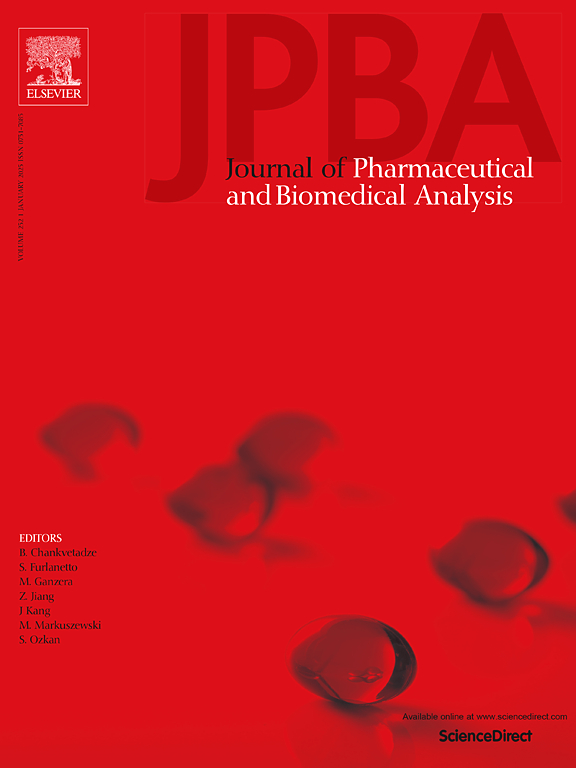Proteomic study of plasma and L1CAM-captured exosomal proteins in children with autism spectrum disorders
IF 3.1
3区 医学
Q2 CHEMISTRY, ANALYTICAL
Journal of pharmaceutical and biomedical analysis
Pub Date : 2025-05-14
DOI:10.1016/j.jpba.2025.116965
引用次数: 0
Abstract
Autism spectrum disorder (ASD) has become a neurodevelopmental disorder that seriously endangers the health of infants and children. In order to explore the pathogenesis of the disease and search for early diagnostic biomarkers. In this study, plasma exosomes (PEs) and neural cell adhesion molecule L1 (L1CAM)-captured exosomes (LCEs) of ASD and controls were extracted and lysed to obtain proteins. Isobaric tags for relative and absolute quantitation (iTRAQ) proteomics were applied to investigate the differences in the expression of PEs and LCEs proteins between the two groups. Twenty-eight plasma exosomal differentially expressed proteins (DEPs) were identified, which were mainly associated with immunity, inflammation, complement and coagulation, and lipoprotein metabolism and transport. Twenty L1CAM-captured exosomal DEPs were identified, which were mainly involved in cytoskeleton, tight junctions, focal adhesion, and platelet-associated pathways. Meanwhile, our results suggested that processes or signaling pathways associated with the DEPs from plasma exosomes may be activated, whereas those associated with L1CAM-captured exosome may be inhibited. These processes or signaling pathways have been reported to be associated with ASD in previous studies. These DEPs have the potential to be diagnostic markers. This study provides new insights into disease mechanisms and diagnostic markers of ASD.
自闭症谱系障碍儿童血浆和l1cam捕获的外泌体蛋白的蛋白质组学研究
自闭症谱系障碍(ASD)已成为一种严重危害婴幼儿健康的神经发育障碍。为了探索疾病的发病机制,寻找早期诊断的生物标志物。本研究对ASD患者和对照组的血浆外泌体(PEs)和神经细胞粘附分子L1 (L1CAM)捕获的外泌体(LCEs)进行提取和裂解,获得蛋白质。应用等压标签相对和绝对定量(iTRAQ)蛋白质组学研究两组间pe和LCEs蛋白表达的差异。共鉴定出28种血浆外泌体差异表达蛋白(DEPs),它们主要与免疫、炎症、补体和凝血以及脂蛋白代谢和转运有关。共鉴定了20个l1cam捕获的外泌体dep,它们主要参与细胞骨架、紧密连接、局灶性粘附和血小板相关途径。同时,我们的研究结果表明,与血浆外泌体的dep相关的过程或信号通路可能被激活,而与l1cam捕获的外泌体相关的过程或信号通路可能被抑制。在以前的研究中,这些过程或信号通路已被报道与ASD有关。这些dep具有作为诊断标记物的潜力。本研究为ASD的发病机制和诊断标志物提供了新的认识。
本文章由计算机程序翻译,如有差异,请以英文原文为准。
求助全文
约1分钟内获得全文
求助全文
来源期刊
CiteScore
6.70
自引率
5.90%
发文量
588
审稿时长
37 days
期刊介绍:
This journal is an international medium directed towards the needs of academic, clinical, government and industrial analysis by publishing original research reports and critical reviews on pharmaceutical and biomedical analysis. It covers the interdisciplinary aspects of analysis in the pharmaceutical, biomedical and clinical sciences, including developments in analytical methodology, instrumentation, computation and interpretation. Submissions on novel applications focusing on drug purity and stability studies, pharmacokinetics, therapeutic monitoring, metabolic profiling; drug-related aspects of analytical biochemistry and forensic toxicology; quality assurance in the pharmaceutical industry are also welcome.
Studies from areas of well established and poorly selective methods, such as UV-VIS spectrophotometry (including derivative and multi-wavelength measurements), basic electroanalytical (potentiometric, polarographic and voltammetric) methods, fluorimetry, flow-injection analysis, etc. are accepted for publication in exceptional cases only, if a unique and substantial advantage over presently known systems is demonstrated. The same applies to the assay of simple drug formulations by any kind of methods and the determination of drugs in biological samples based merely on spiked samples. Drug purity/stability studies should contain information on the structure elucidation of the impurities/degradants.

 求助内容:
求助内容: 应助结果提醒方式:
应助结果提醒方式:


